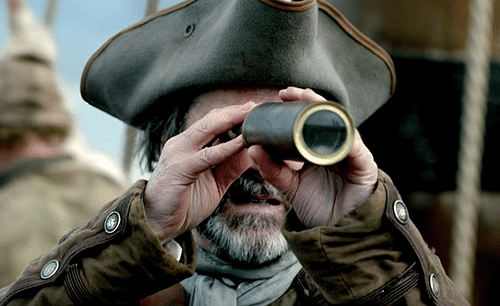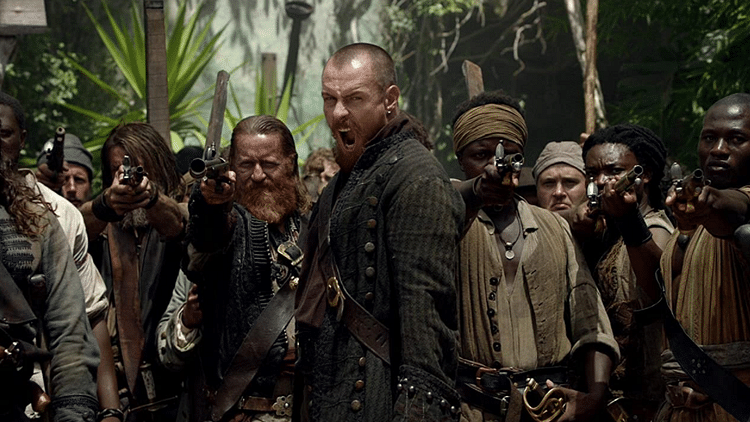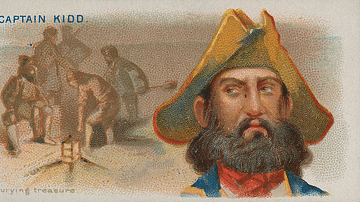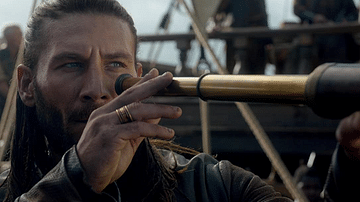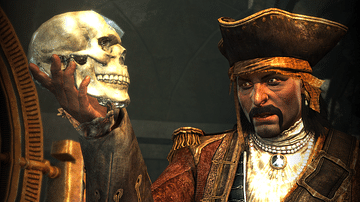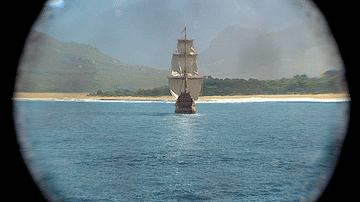It was all very well pocketing other people’s valuables and roistering at rum parties, but life on a pirate ship involved a surprising amount of hard work. Pirates were first and foremost sailors and in the Golden Age of Piracy (1690-1730), a pirate ship required a great deal of skill to operate and constant maintenance to keep afloat. Indeed, pirates had to be remarkably good seamen if they were to ever catch fleeing merchant vessels and escape the unwanted attentions of heavily-armed naval vessels. From captain to rigger, each crew member played their part in the complex performance of tasks that kept a 17/18th-century sailing ship in trim.
The Captain
The captain of a pirate ship was very often the arch-criminal brains of the pirate operations. He might also have been the one who had put up the capital to buy the ship or been its legitimate captain or a high-ranking officer on a privateering vessel before the crew had decided to take to a life of piracy.
Perhaps surprisingly for a gang of cut-throats, a pirate captain was frequently elected to his position, but then again, it was difficult to lead through coercion a group of individuals who valued their liberty above all else. Many mariners had turned to piracy precisely because of the strict discipline and harsh punishments of life on a merchant or naval ship and so they were hardly likely to put up with a leader who ruled by the rod alone. Nevertheless, the most successful captains, those who captured large prizes, could instil some rules and discipline on their men, such as Bartholomew Roberts (1682-1722) who insisted his crew refrain from gambling in the ship’s articles which all his crew swore to abide by. The position of captain might not be permanent either, since sailors who had mutinied once before were not shy to do so again. Charles Vane (d. 1721) was relieved of his command for failing to attack a ship as his crew had wished and was replaced by 'Calico Jack' (aka John Rackham, d. 1720).
Pirate captains often dressed the part in the Golden Age. Blackbeard (aka Edward Teach, d. 1718) went for terror with a ribboned beard and lit fuses under his hat while Roberts sported scarlet silks, a feathered hat, and a diamond necklace. Having a nice long coat and plenty of pricey pistols were other ways of showing one was a successful leader of pirates.

With his skills at leadership, navigation, and sheer charisma, a pirate captain earned his double share of the loot captured compared to other crew members. On the other hand, if the pirates were caught, the captain could expect the worst judgement of the authorities. While many pirates faced a real risk of being hanged, the pirate captains were almost guaranteed such a fate, and the most notorious ones might also have their corpses hung in chains to rot for years like Captain Kidd in 1701.
Quartermaster
A pirate quartermaster (as opposed to one on more legitimate vessels) was often the second-in-command, and below him were the first and second mates. He was, then, the equivalent of a merchant First Mate or a naval First Lieutenant. Like the captain, the quartermaster could be voted in or out of office by the crew. The helmsman, the man who steered the ship’s wheel, was usually supervised by the quartermaster who, skilled in navigation, was also concerned with the ship’s general course and with recording its speed, although this role could be taken by a pirate captain or a sailing master (who was expert in the ship’s sailing capabilities in all conditions). The quartermaster usually supervised which men boarded a target vessel, leading the attack himself. After the takeover, he decided what loot was taken, and then he ensured its fair division amongst the crew. The quartermaster’s share of booty was the same as the captain's: double the share of an ordinary seaman. In the rare case that the crew had voted for one of their brethren to be flogged, it was the quartermaster who dished out the punishment. When a pirate captain captured a second ship and wished to maintain a fleet of his own, the quartermaster was the prime candidate to become its captain.
Navigator
The ship might have a dedicated navigator, and although the captain and quartermaster often had knowledge of navigation, a specialist was preferred since he was familiar with charts, coastlines, currents, winds, and local weather conditions. Longitude could still not be measured with accuracy in this period and so practical experience was a great advantage. With a good navigator, a pirate captain could arrive exactly where he knew merchant ships frequently sailed and he could negotiate dangerous shallows and islands, which would offer excellent places to ambush a passing ship. Sometimes a pirate fleet of ships had a single specialised navigator. As few mariners knew the mysterious art of navigation, the ship’s navigator was often called the Artist.
Boatswain
The boatswain (often simply 'bosun') supervised all those tasks requiring seamanship and was responsible for the ship’s stores and ensuring the ship’s rigging, sails, and anchors were in good working condition. The bosun received one and half times an ordinary seamen’s share of booty. If the crew were large, then the bosun was assisted by deputies, the bosun’s mate or mates.
Officers
While pirate crews had no formal rankings, as such, some seamen were definitely above others in terms of their knowledge and experience. Such individuals, as on legitimate ships, organised the ordinary seamen in their daily duties when at sea. A foremast man, for example, supervised a team of five or six seamen. The coxswain (who could be a bosun’s mate and is pronounced 'cox’n') steered the ship (when he could be known as the helmsman) and was in charge of any small boats on board - useful for going ashore, exploring shallows, and boarding other vessels. Officers received one and a quarter of an ordinary seamen’s share of any booty taken.
Having a doctor on board was an advantage but depended on whether one could be coerced into joining the crew. If not, then having a medicine chest was the best a captain could do to reduce the effects of illness and injury on his crew. In the absence of a surgeon, the ship’s carpenter was called upon to perform such drastic operations as amputations.
Carpenter
Any sailing ship needed a good carpenter to keep the vessel in good trim, keep on top of any leaks, and make the inevitable and constant running repairs caused by wind, sea, tropical marine creatures, and enemy fire. The carpenter on a pirate ship also needed additional skills like refitting a captured vessel to make it more suitable for its new role. Speed was of the essence and so superstructures might be removed to reduce weight and increase speed and manoeuvrability. Additional gun ports might need to be cut in the ship’s hull and internal bulkheads removed to make way for more cannons. Then there were the repairs to masts and stays smashed by cannon fire. No wonder, then, that when a pirate ship captured a merchant vessel, the skilled carpenter on board was very often press-ganged into service, and he was obliged to wave goodbye to an honest and considerably longer life. The carpenter received one and half times an ordinary seamen’s share of booty.

Cooper
A cooper was only found on board a larger vessel, but he was very useful as he could assemble barrels, a key skill because, at the time, these were the only large containers available and were used for keeping dry stores, wet stores, water, rum, and gunpowder in. He ensured they remained as airtight and watertight as possible, and he could dismantle empty barrels to increase space for newly captured cargo. The cooper also made and repaired buckets.
Sailmaker
Like the carpenter, blacksmith, and cooper, this was a specialist artisan job, and the man skilled at it need not necessarily know any other skills of seamanship. Sails were always worn down by weather, often ripped up by storms, and sometimes riddled to pieces by grapeshot. In the age of sail, the sailmaker was as important as the chief engineer on a modern ship, since without him the vessel could not go very far. In the absence of a ship’s surgeon, one of the sailmaker’s duties was to stitch wounds from battle and the all-too-frequent accidents on board a sailing ship.
Gunner
The ship’s team of cannon operators was led by the gunner, who shouted the order 'Fire!' and who was assisted by a gunner’s mate. Each cannon on a pirate ship required 4 to 6 men to operate. Experience was required to measure the correct amount of gunpowder to fire varying projectiles at the distance required to hit the target. In addition, the ship on which the cannon was being fired and the target were often both in motion horizontally and vertically if under sail and not in a dead calm. Fortunately, few pirate captains wanted to seriously damage a target ship for fear of similarly damaging its precious cargo, but if a merchant ship decided to put up a fight after the Jolly Roger was hoisted or the pirates were under attack from a naval vessel sent by a colonial governor to hunt them down, then being a good shot was an obvious advantage. Another advantage was the speed with which a practised gun crew could fire off multiple shots. On a pirate ship, cannon operators were not full-time and so they had other duties when not in battle. A gunner received one and half times an ordinary seamen’s share of booty.
Cook
Although pirates enjoyed food taken from captured ships and at taverns when in a pirate haven, they still needed someone to cook on a regular basis while at sea in pursuit of victims. The cook on a pirate ship (or any other, for that matter) was often a mariner who had lost a limb in action, a fact which did not go unnoticed by Robert Louis Stevenson in his 1883 novel Treasure Island, where Long John Silver, we are told, once served as a cook before he became a pirate.
Musicians
Musicians such as a fiddler and trumpeter were a part of any crew, including pirate ships. They were useful as a source of rhythm to aid manual tasks like pulling rigging, to create a cacophony of noise which contributed to the general terror of a pirate attack, and, as in other ships, they were at the beck and call of any of the crew who had the impulse to be entertained.
Ordinary Seamen
Most pirate crews were composed of either mutineers or those captured by other pirates and forced to join them or be killed (the latter case was certainly the most common defence plea in pirate trials). Those taken included ship’s boys who were serving as apprentices or as general dogsbodies performing cleaning and serving duties. Recruits might also come from mariners tired of the hard work and discipline expected on merchant and naval ships - not to mention the poor pay - or those who could take no more of the harsh conditions endured by such occupations as Newfoundland fishermen. There were also those who were attracted by the idea of a life at sea and an escape from the monotony of their job on land. Workers in lumber factories in tropical climates rife with disease were particularly keen for the fresh air of the sea and the chance to gain a fortune. Finally, the frequency of captures, sinkings, casualties, accidents, and disease all meant that pirate crews were usually short-staffed.
Captains looked to pirate havens for recruits, places like Tortuga, Providence Island, and Port Royal, which were usually bustling with pirates looking for a new ship to join. Pirate crews in the Caribbean during the Golden Age were made up of all nationalities, but the majority were either British or colonists from the Americas. Black Africans, slaves either captured and press-ganged or volunteers or slaves who had escaped from colonial plantations, were a not insignificant part of private crews. Black African slaves would have had no knowledge of seamanship and so were likely employed as servants or for the more menial tasks on board, but there is evidence in trial records that some learnt the ropes and became equal members of the crew.
To qualify for life on a pirate ship as the lowest-ranked seaman, the skills required were to be able to manage sails (extending, reefing, and furling), to steer, and to take soundings; being handy with a weapon was a distinct bonus, as was not being too particular about one’s company. Another requirement was youth since a hard life at sea was a young man’s game and so few pirates (or mariners of any kind) were aged over 40, and most were in their twenties.
The benefits of a pirate’s life were better food, better pay (perhaps many years of wages in one go if a good prize was taken), plenty of alcohol, and the chance for freedom and adventure. There was, too, a greater sense of involvement in the ship’s affairs, since very often key decisions and the distribution of booty were organised along democratic lines. The disadvantages included a very real risk of imprisonment, hanging, or serious injury. The average career of a pirate was around two years, and in all likelihood, once turned pirate, one would never see one’s family ever again.

